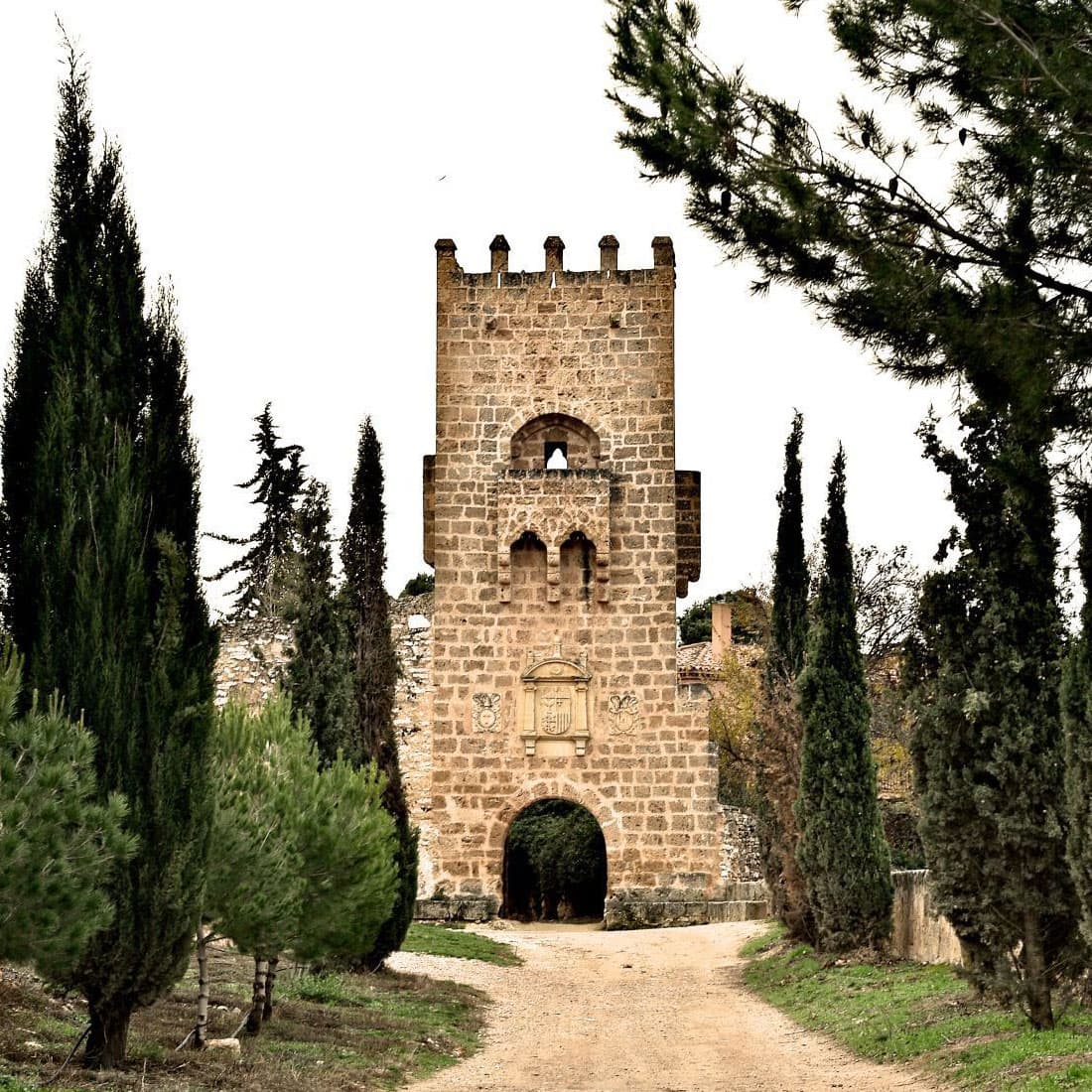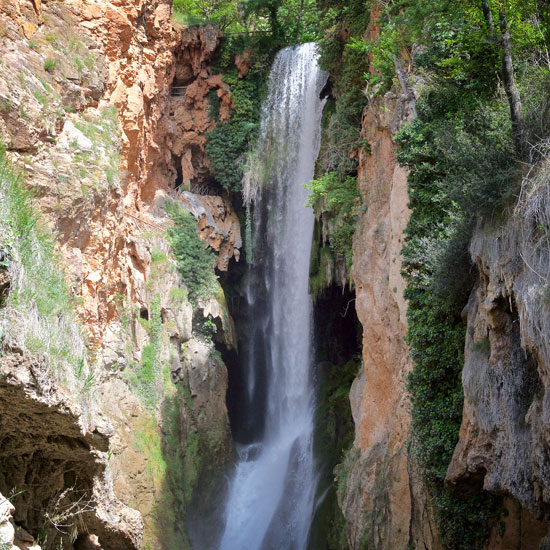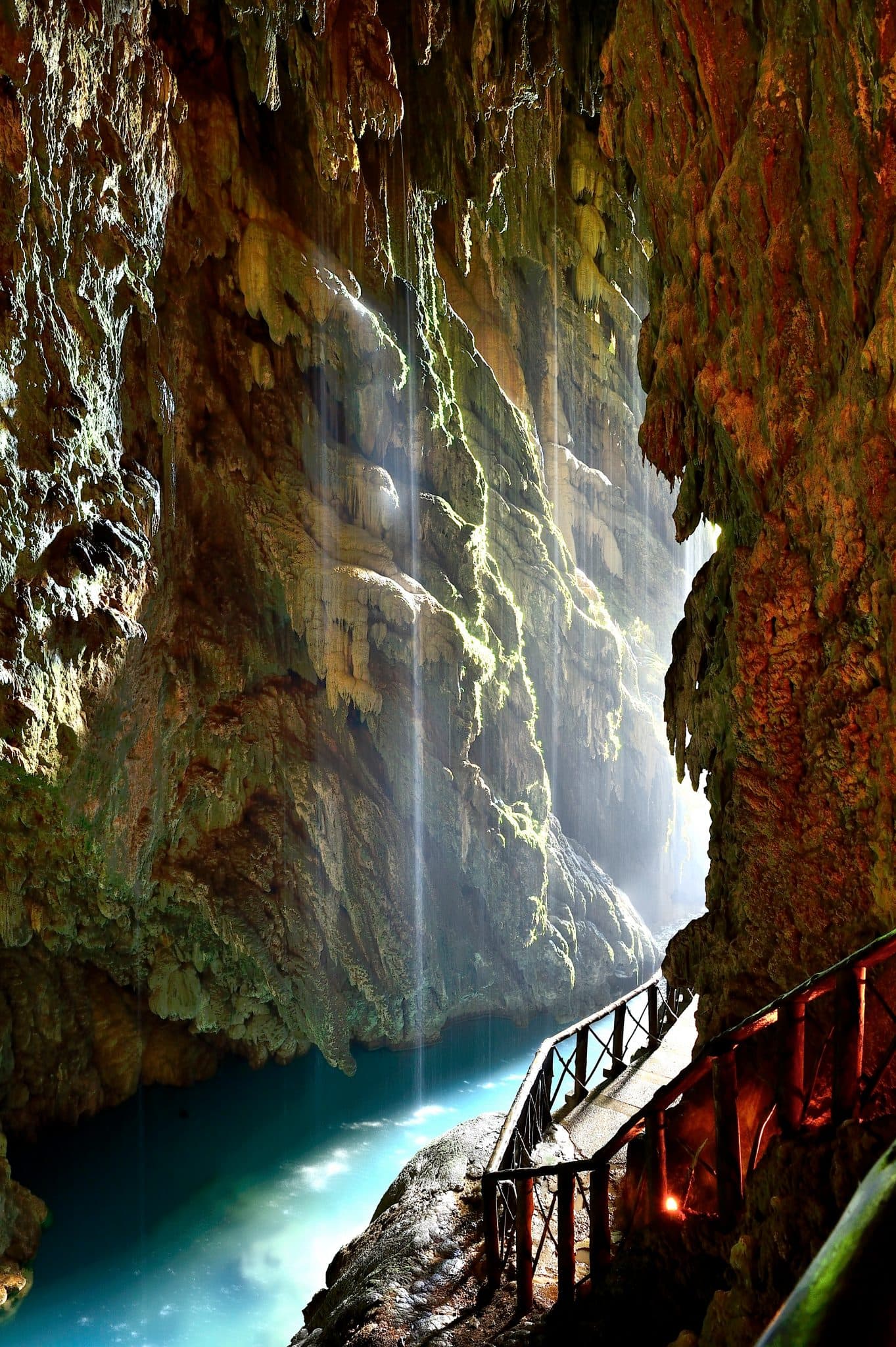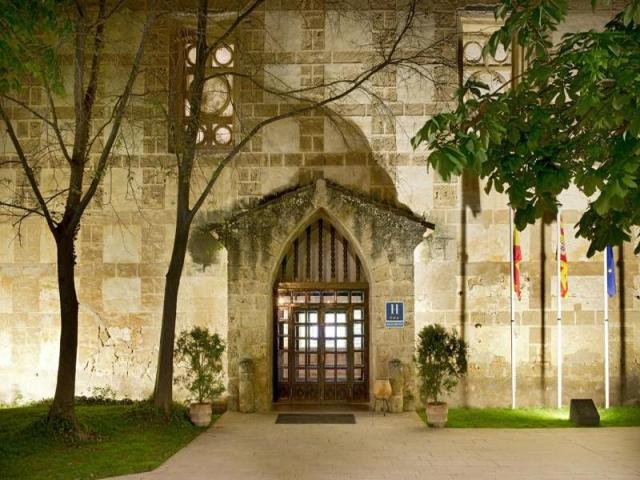Introduction
Tucked away in the Iberian System mountain ranges, approximately twenty-five kilometers from Calatayud, lies an emerald oasis unknown to many: the Monasterio de Piedra. This gem, arguably one of the most visited natural sites in Spain, surprises its visitors with a spectacle of waterfalls, lush vegetation, and tranquil ponds, a stark contrast to the arid landscapes of Zaragoza.
Our journey to this verdant paradise begins with a drive through diverse terrains. The road, both wide and firm, challenges with its bends and slopes, hinting at the seclusion and peace that the destination promises. Amidst this, one can’t help but wonder what drove the Cistercian monks in 1164, seeking solitude from their tranquil existence in the Monastery of Poblet, to this remote and hidden gorge.
The Monasterio de Piedra doesn’t give away its secrets easily. What remains of the old monastery offers no answers, only a testament to times long past. The spiritual retreat plunged into decline following the forceful departure of its last residents. In 1835, a repercussion of Mendizábal’s disentailment, the monks were compelled to leave, and the hallowed halls fell into silence. The edifice remained unoccupied until, fifteen years later, the Muntadas family purchased and transformed it, partially into a hotel. This shift marked the monastery’s dual existence today: one part inviting lodging, where former monk cells serve as cozy accommodations, and the other a hauntingly beautiful blend of Gothic, Renaissance, and Baroque ruins nestled within nature’s embrace.
Today’s Monasterio de Piedra is a harmonious coexistence of history and leisure. Guests sleep within walls steeped in history, their dreams perhaps mingling with whispers of the past. By day, visitors explore the grounds, where architectural grandeur and natural beauty converge. Each corner of the park holds its unique charm, from the playful chatter of cascading waters to the serene stillness of hidden ponds.
But what truly sets the Monasterio de Piedra apart is its incredible water gardens. Imagine a place where crystal-clear streams dance around ancient ruins, where every step forward invites a new perspective of awe and wonder. The murmuring waters, having witnessed the silent passages of time, now serenade the spectacular greenery surrounding them.
The experience of wandering through this water garden is nothing short of therapeutic. As the sun filters through the foliage, casting dappled shadows over the time-worn stones, one is reminded of the enduring presence of nature, persisting and thriving amidst the echoes of human history. The gardens serve not just as a home to diverse flora and fauna but also as a sanctuary for the soul, offering respite from the hustle of modern life.
Visiting the Monasterio de Piedra is more than just a walk through a park; it’s a journey through history, art, and nature. It’s a dialogue with the past, set against the backdrop of thundering waterfalls and peaceful lagoons. Whether you find yourself drawn to the mystery shrouding the ancient ruins or seeking solace in the garden’s natural tranquility, a day at the Monasterio de Piedra will leave you rejuvenated and inspired.
The magic of the Monasterio de Piedra lies in its ability to be a silent witness to the past while offering a peaceful retreat for the present. It stands as a reminder that beauty flourishes at the intersection of human endeavor and nature’s magnificence. So, when in Zaragoza, allow yourself the gift of experiencing this enchanting site, where every pathway promises a new story, and the whispers of history are drowned out only by the soothing symphony of water.

A hidden water garden in Zaragoza awaits
In the realm of Zaragoza lies an exquisite blend of history and nature, the Monasterio de Piedra, a testament to time, faith, and the relentless force of nature. Recognized as a canvas of the past, this magnificent monastery captures the essence of both the glory and decline it has witnessed since its inception in 1218, up until its transformation post-1835, following the upheaval caused by Mendizábal’s disentailment law.

As the first abbot, don Ximeno Martínez might never have envisioned the turbulent yet enriching journey the monastery would undertake. From times of prosperity to moments of ill-advised decisions that disfigured the sanctity of its temple with plaster, cornices, and cherubic figures in the mid-18th century, the Monasterio de Piedra endured. The repercussions of the liberal revolution stripped much from its original foundation, yet, against the odds, notable structures remain. Visitors can still marvel at the square Torre del Homenaje, the lower gateway, the austere arcades of the lower cloisters, the kitchen, the refectory, the chapter hall, and remnants of its monumental church.
Beneath these relics, a crypt holds a lineage of abbots laid to rest since 1617, preserving a strict succession order, a silent homage to the monastery’s spiritual legacy. Adding to its historical tapestry is the stunning Churrigueresque door, ranking among the finest examples of its style, an artistic cry from a later period but no less worthy.
Beyond the architectural wonder, the Monasterio de Piedra finds its soul in its surroundings, crafted by two diverse forces: the River Piedra and mankind. The former sculpted gorges and bestowed lush vegetation, while the latter introduced balustrades, marked paths, ponds, and pragmatically, the admission booth. This interplay has birthed a natural haven, enticing visitors with its verdant allure and tranquil ambiance.
Embarking on the monastery park’s journey, well-signposted and straightforward, some stretches prove challenging, damp and slippery, as the youthful river, indulging in its playful moods, oscillates between being a cascading waterfall and a meandering stream. This playful spirit is most pronounced en route to the “Cola de Caballo” waterfall, guided by red-arrowed signs, a path that reveals nature’s unbridled artistry. Surrounded by limestone walls dotted with moss and crowned by a splendid ash grove, the waterfall plunges dramatically, a 50-meter descent. The tableau of sky blue, radiant green foliage, and the vigorous white water will captivate all who wander into this hidden water garden.

In this serene corner of Zaragoza, the Monasterio de Piedra presents more than just historical edifices; it offers a sanctuary where the past melds with the present, inviting its visitors to partake in the peace that once inspired the creation of this spiritual retreat, now one of the most cherished tourist attractions in Spain. Here, amidst the whispers of cascading waters and the silent narratives of ancient stones, one finds not just a destination, but an experience that resonates with beauty and history.
Discover the enchanting waterfalls and caves of Monasterio de Piedra
The Monasterio de Piedra offers an enchanting escape where waterfalls cascade, caves beckon, and nature’s uninterrupted symphony plays. This oasis, celebrated for its tranquil gardens and historical roots, reveals another layer of intrigue through its hidden waterways and the symphony of its avian residents.
Behind the monastery’s famous cascades lies a secret world, etched into the landscape over millennia. The most mesmerizing of these is a spacious grotto behind the waterfall, discovered by Federico Muntadas in 1860. Entry into this chamber demands a descent via a staircase characterized by its low ceiling, narrow configuration, and steep steps. Here, a waterproof jacket becomes a necessity, along with cautious footing. For those less confident in their balance, an alternative, more accessible route exists. However, this path makes it challenging to witness the pigeons nesting within the cave or venture to the lookouts offering breathtaking views of the water’s surge.

Eagle-eyed visitors are rewarded throughout their stroll, with the continuous comings and goings of eagles, owls, and sparrowhawks. These birds, relying on the park’s protection, nest in the cliffs opposite the lookouts. Their presence adds a vibrant pulse to the serene backdrop of the Monasterio de Piedra.
Beyond these living treasures, the falls of Iris and Trinidad, along with the Carmela and Pantera caves, stand as testaments to nature’s slow artistry, sculpting beauty in hidden corners. This environment is a harmonious blend of water, rock, and an expanse of green. Moss-covered walls, shrubbery, and wide paths flanked by small forests create a vivid tapestry where walnuts, ashes, and hackberries thrive alongside poplars, elms, and elder trees. These diverse species compete healthily, casting shadows over a plush, colorful undergrowth.
As visitors approach the park’s end, where the River Piedra prepares to calm its flow into the nearby Tranquera reservoir, a crystalline waterbed emerges as a surprise. This clear pool, bordered by a hill strewn with hackberries and the so-called “Devil’s rock,” resembles a finely crafted crystal urn. Everything within it, whether growing or resting, glimmers in the still, pooled tranquility, a serene contrast to the river’s earlier fervor.
The stone lends its name to the river and forms the foundation of both the park and the ancient monastery. Contemporary travelers may ponder whether the original monks might have succumbed to a touch of pride when selecting this site for their retreat. Indeed, the Monasterio de Piedra and its surroundings seem almost a lavish gift from the natural world, a place where the spiritual and the sensory coalesce in perfect harmony.
This destination is not merely a visit; it is an invitation—a call to immerse in a world where history whispers from the stones, and nature sings from the waterfalls. The Monasterio de Piedra is a timeless journey, an experience that resonates deep within the soul, long after the echoes of the water’s song fade.
The conventual kitchen: Culinary traditions within Monasterio de Piedra’s ancient walls
Within the time-honored walls of the Monasterio de Piedra, visitors have the unique opportunity to step into the past and explore the culinary heritage preserved in the remnants of the original monastery. Among the most intriguing are the spaces dedicated to wine production and the ancient art of cooking. These areas offer a glimpse into the daily lives of the monks who once sought spiritual solace in this serene retreat.
The winemaking process, integral to monastic life, unfolds in the monastery’s cellars, divided into two significant sections. The first room, where grapes were once received, now serves as an exhibition space, showcasing the various implements used in viniculture. Here, guests can visualize the initial stages of winemaking. Adjacent lies the fermentation room, where, centuries ago, the monks would monitor the transformation of grape into wine, a process almost as mystical and profound as their religious rites.
However, it is the kitchen that truly piques visitors’ culinary curiosity, holding the distinguished title of being the first in Europe where chocolate was prepared and cooked. This fact alone underscores the innovative spirit and openness to new experiences and tastes that the monastery’s inhabitants embraced. In this hallowed space, monks would prepare meals that were more than just sustenance, using them as a form of communion.
Once dishes were ready, they were served in the refectory, a dining area with a quadrangular layout known for its excellent acoustics. This characteristic was crucial as it was customary for one of the monks to read from the Bible from a pulpit while the others partook in their meal. This tradition underscores the seamless integration of spiritual and physical nourishment, with the spoken word enhancing the simple act of eating.

The Monasterio de Piedra’s culinary spaces narrate tales of a self-sustaining, innovative community that thrived on meticulous craftsmanship, from the delicate art of chocolate preparation to the intricate process of winemaking. These practices were not merely about feeding the body but also about nurturing the soul, turning every meal into a form of prayer and reflection.
Visitors today are invited to wander these ancient rooms, where the aromas of rich chocolate and fermenting grapes seem to linger in the air, offering a deeply sensory connection to the past. It’s a reminder that within these walls, culinary artistry became a pathway to divine communion—a tradition that continues to inspire and intrigue to this very day.
Planning your visit to Monasterio de Piedra: A haven of history, nature, and gastronomy
After immersing yourself in the tranquil beauty and historical intrigue of Monasterio de Piedra, you’ll likely want to extend your stay to experience everything this unique destination has to offer. Here’s how you can make the most of your journey to this enchanting locale.
Getting there
From Zaragoza, the most straightforward route is taking the N-II to Calatayud. From there, continue on the A-202 road until you reach Nuévalos, which serves as the gateway to the protected natural area of Monasterio de Piedra.

Accommodation
The Jalón River valley boasts a broad range of accommodations, including guest houses, hostels, and hotels. However, for a truly memorable stay, consider lodging at the Hotel & Spa Monasterio de Piedra. This 12th-century Cistercian monastery now functions as a comfortable hotel, where rooms are situated in the monks’ former cells, offering maximum comfort within a historical setting.
Positioned in the newer cloister, constructed in the 17th century, the hotel can accommodate up to 140 guests across 62 rooms. Facilities include an outdoor pool, spa area, restaurants, lounges, bars, and event spaces. The hotel is also pet-friendly, welcoming well-behaved dogs. For reservations, please call 976 870 701.
Each room offers views of either the Park or the Cloister and includes amenities such as a minibar, safe, and private bathroom. Some rooms feature a terrace. For more information, visit: Hotel Monasterio de Piedra.
Indulgence for body and soul
The hotel’s spa, spanning over 500 m2, promises relaxation under medieval vaults. Here, guests can enjoy hydrothermal circuits, a Frigidarium (cold pool), chromatic mist showers, a Hamman, Finnish sauna, and a relaxation area with heated beds. The spa operates from 11:00h to 20:00h, with access restricted to guests over 14 years of age. For inquiries or reservations, contact: 976 87 07 07 or spa@monasteriopiedra.com.

Gastronomic delights
The region’s cuisine, rich in pork and lamb, offers must-try dishes like ‘ternasco,’ ‘pollo al chilindrón,’ and pickled partridge.
Monasterio de Piedra features two restaurants, serving everything from traditional to avant-garde cuisine. Restaurante Reyes de Aragón offers a creative, seasonal menu under the guidance of Chef Nacho Morales, while Restaurante Piedra Vieja is perfect for guests seeking a traditional meal, with options like a daily menu, a la carte dishes, and pizzas.
Local shopping and activities
For wine enthusiasts, a trip to Ateca is essential to sample the renowned Castillo de Alcocer red wine. The region’s fruits also enjoy a reputation for their quality.
In addition to its natural and historical attractions, Monasterio de Piedra offers activities like horseback riding, cycling, and hiking. Nearby spas provide further relaxation opportunities. For more information, visit the Nuévalos Tourist Office in Plaza de España or check the website: Monasterio de Piedra.
Conclusion
Monasterio de Piedra emerges as a unique destination that combines history, nature, and relaxation in an environment of incomparable beauty. Immersing yourself in its gardens is like delving into a natural history book, where each waterfall has its legend, and every corner hides a piece of Cistercian history.
Arriving is straightforward, and the journey itself is part of the experience, plunging visitors into the characteristic landscapes of the Zaragoza region. Accommodation within the monastery itself provides an unparalleled experience, where luxury and comfort are framed by the solemnity and tranquility of ancient monastic cells. The culinary offerings, celebrating the best of local and innovative cuisine, complement a day of exploration and wonder.
However, to ensure an enriching and safe experience, it’s crucial for visitors to heed the rules and recommendations. The preservation of this historic enclave depends on respect and consideration for the natural space and facilities, requiring conscious and responsible conduct. This includes adhering to accessibility indications, proper dress, and restrictions on food and drink, as well as compliance with specific rules for overall safety and enjoyment.
A visit to Monasterio de Piedra is not just a trip to a historic monument but an immersion in a cultural legacy that has survived the passage of centuries. Each path, each stone, and each droplet of water tells a story, inviting visitors to leave behind the mundane and immerse themselves in a world where nature and history coexist in harmonious union. For all these reasons, Monasterio de Piedra stands as a must-visit getaway for those looking to enrich their spirit, nurture their well-being, and expand their understanding.





